

|
| ||
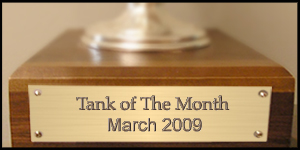
Keith Berkelhamer's (ReefBum) Reef Aquarium One of the things I love about reef keeping is that it is a constant learning experience. The knowledge gained from others and your own successes and failures is invaluable. Despite achieving success back in 2003 with Tank of the Month honors, I learned a valuable lesson about keeping things consistent and doing the proper homework. My tank crashed a year after receiving that honor but the insights I gained from the crash made me a better reef keeper.
Birth of a New TankMy old 120-gallon tank had a flaw I wasn’t aware of until it was too late. I used about 250lbs of live rock for the tank and, in retrospect, it was too much. It seemed fine at first but my reef matured quickly and ultimately my corals ran out of room. The growth restricted flow and I also battled some nuisance algae, which essentially led to the tank’s demise when I added too much phosphate removing media. 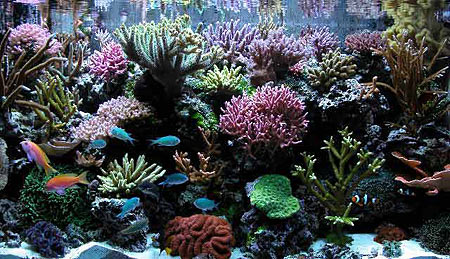
The battle to save the tank took a lot out of me so I decided to take a break from reef keeping. It ended up being a two and a half year hiatus when my family and I decided to move to a new house. It was great not having to worry about the burdens that go along with maintaining a reef but I found myself in serious withdrawal. I still lurked on the Reef Central discussion board and I even went online to check out new corals for sale despite having no place to put them! Yes, I was an addict and it was not a matter of if but when I would start a new tank. Eventually I placed the order but my timing wasn’t perfect since it arrived during one of the biggest snow storms of the year! In regard to the layout of the new tank, the time without a tank afforded me the opportunity to do a lot of research and some extensive planning. I studied other build threads and used my past experiences to come up with a design for a bigger (225-gallon) and more open tank. My old tank was built in the wall so I wanted the new aquarium to have more viewing options and angles. I went with an open top since it would provide four viewing dimensions, including each side, the front and top. The new tank would also have an open aquascape with enough room for corals to grow and space for fish to roam. Two islands were created from seven pieces of live rock that weighed approximately 200lbs. Of course now I need more room! 
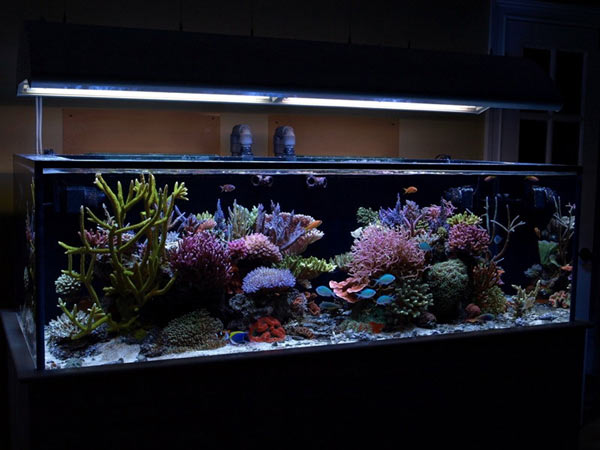
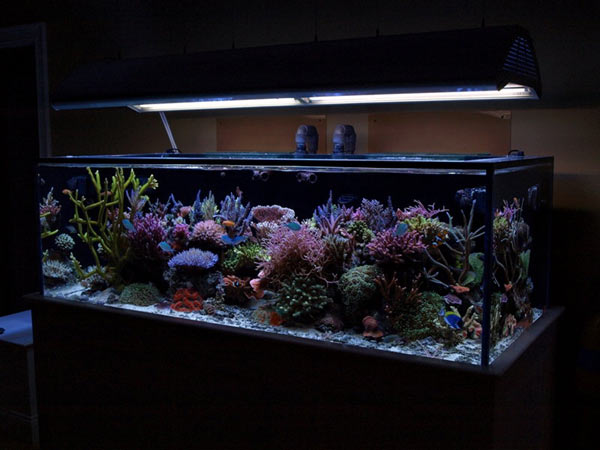
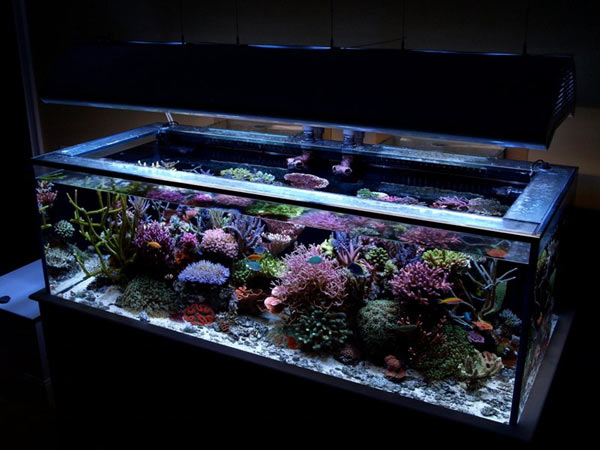
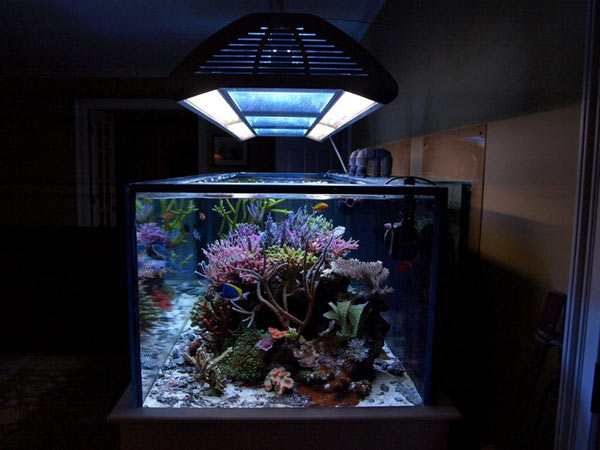
One unique aspect of the design was to keep a space between the rock structure and the back of the tank, a layout that would further enhance flow and circulation. 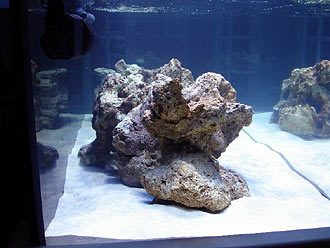
This would also give me access to the back panel to keep it clean and allow the corals to “pop” against a black piece of acrylic siliconed to the back glass. 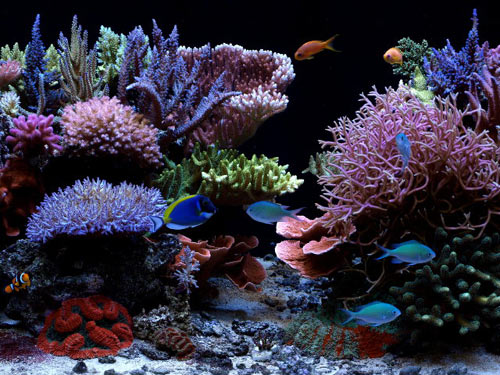
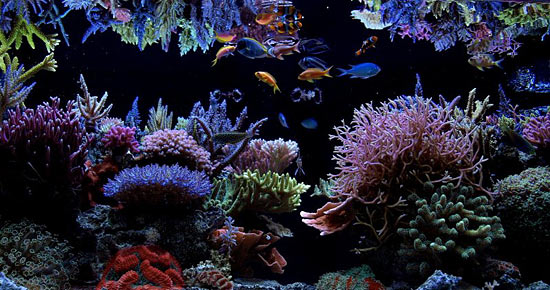
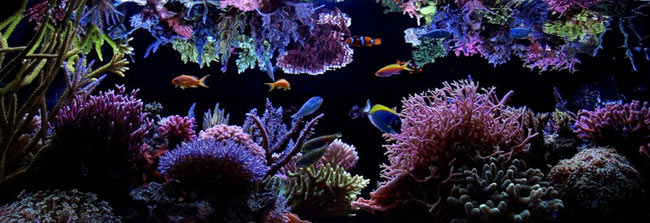
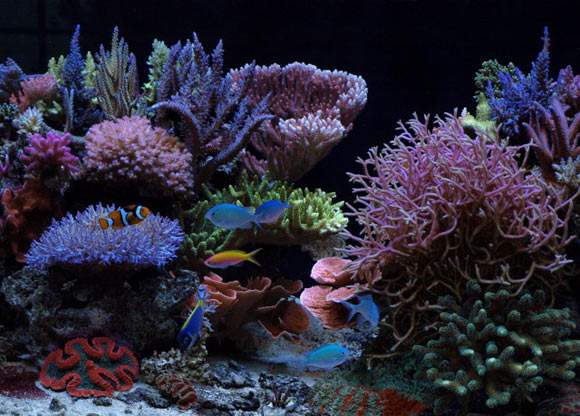
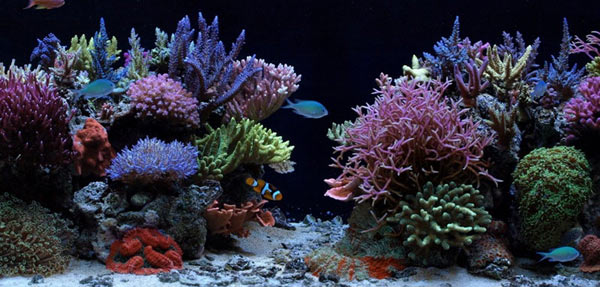
The acrylic was applied on the inside to cover the outlines of the silicone used to attach the external overflows, which created extra space and added to the clean and open look I was seeking. Tank and Equipment RoomsThe tank is in the living room and most of my equipment is downstairs in the unfinished basement. Nothing is kept inside the stand, although I did build a wood box that sits a couple of feet to the left to house some equipment for the lights and other miscellaneous items. Wires are hidden behind a piece of plastic running along the baseboard. 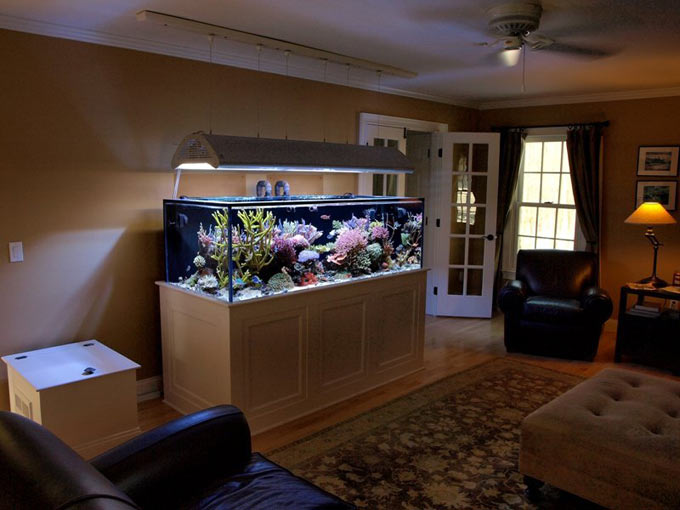
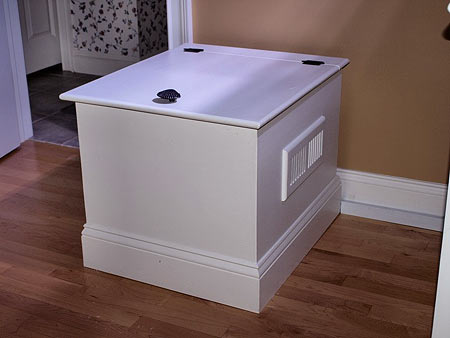
Supports were added in the basement and a large section of the area was turned into the “nerve center” of my operation. The room housing the tank was receiving a make-over so I had the floor guy cut a hole in the new maple floor to accommodate the PVC pipes for the drains and returns. The hole was cut to the size of a standard wood vent cover in case the tank is dismantled; something I hope is a long way off! I did all the plumbing myself and was gratified to hear how impressed my plumber was with the work. Perhaps he can get me future supplies at wholesale. :) System Profile
FiltrationA 90-gallon custom sump sits on a workbench and has a cover to cut down on evaporation and keep metals in my basement protected from the corrosive elements of salt water. Two Blueline 70 external pumps (1,750-gallons per hour per pump) draw water from the sump and return it to the tank. One of the pumps passes water through a one-half horsepower Tradewind in-line chiller and an Iwaki MD-100RLT external pump drives water from the sump to a 50-inch dual beckett protein skimmer from Marine Technical Concepts (HSA-3000). 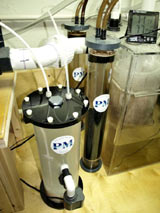 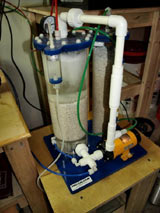 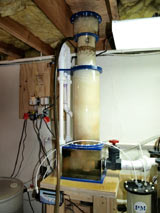 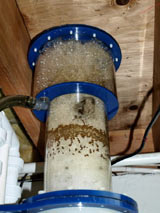 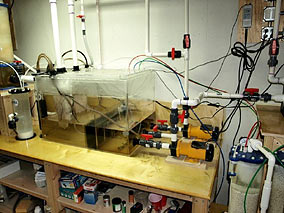
In addition to the 200 lbs. of live rock (Tonga), 100 lbs of live aragonite reef sand rounds out the biological bed. Mechanical filtration consists of two filter bags, which catch the water before it enters the sump, and a large sponge wedged neatly into a baffle in the sump. Activated carbon in a Precision Marine substrate reactor keeps the water crystal clear and an identical unit is used as a phosphate reactor to keep nuisance algae at bay. The activated carbon is changed every four weeks and the phosphate remover is replaced after two months. CirculationFlow comes from two main sources: the return pumps and two Tunze 6200s with a Tunze 7095 multicontroller. Despite being downstairs, the return pumps are powerful so I use ball valves to throttle them back a bit. An Ocean Motions dual flex valve splits the stream for each return. The Tunze pumps are positioned in the back corners facing one another along the back panel. This was part of my design to have an open channel in the back of the tank to allow for more circulation. A controller has the Tunze pumps operating on different intervals to create a nice random surge within the tank. Calcium & Alkalinity Supplementation:A Marine Technical Concepts dual chamber PROCAL calcium reactor is the main source used for sustaining calcium and alkalinity levels. The reactor is filled with CaribSea ARM large media and is fed by a small Blueline pump. The media is changed after six months and the 10 lb. CO2 tank generally lasts the same amount of time. A Precision Marine KR620 kalkwasser reactor is utilized to boost the low pH produced by the calcium reactor and for additional calcium and alkalinity supplementation. ESV kalkwasser is used and changed out every four weeks and a LiterMeter dosing pump feeds RO top-off water through the reactor. LightingThe tank is lit by a six foot long Sfiligoi light fixture with three single ended 400-watt bulbs and eight 39-watt T5s. Halides (driven by HQI ballasts) are 20K Radiums while the T5s are UV Actinic White HO bulbs. The fixture also has some moonlights and reflectors that look like mini Lumenarcs. Photo Period
A nice feature with this light fixture is that it gives you the ability to change from 400-watt bulbs to 250-watt bulbs by simply switching a couple of wires around. At one point I was using single ended 250-watt Giesemann Megachrome 14.5K bulbs with good results but I believe better growth rates have been achieved with the 400-watt Radiums. Perhaps I will try 250-watt bulbs and ballasts again in the future given my electricity bill! Other Equipment/Gadgets
Maintenance & HusbandryI perform a 30-gallon water change every week using Coralife salt. Additionally, each week the sponge in the sump is rinsed clean and the sump filter bags are cleaned in the washing machine (of course, no soap is used). Every week I clean the skimmer collection cup and empty the waste cup. The becketts on the skimmer are cleaned every three months. 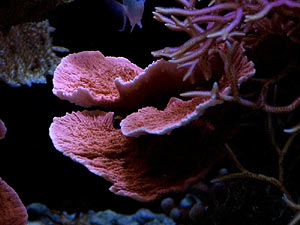 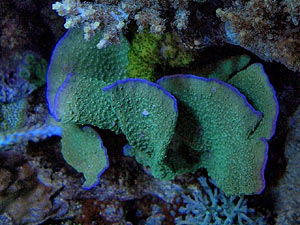
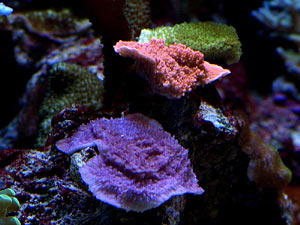
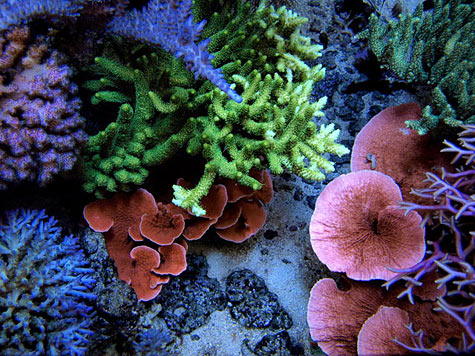
Every other day I use magnets to clean algae from the front and sides of the tank and a scraper to keep the back panel clean. All coralline algae that is missed from my regular scraping routine is removed every three months from the glass and back panel of the tank. I calibrate my pH monitor every month and I clean my Tunze pumps in hot water and vinegar every three months. The return and skimmer pumps are serviced on an annual basis. Weekly tests are conducted using Salifert Ca, dKH and Magnesium test kits. Salifert Phosphate and Nitrate test kits are used on occasion. Water Parameters
Feeding and other AdditivesThe fish are fed daily with two cubes of frozen Mysis shrimp and one Spirulina Brine cube. I put these into a cup of tank water along with some frozen Cyclopeeze and Tropic Marin Pro-Coral Zooton and feed it to the tank with a turkey baster. Right now I’m also experimenting with Roti Feast and Oyster Feast. Pellets are fed on occasion. Elos amino acids are added on a daily basis and Kent Marine Lugol’s solution is added once a week. 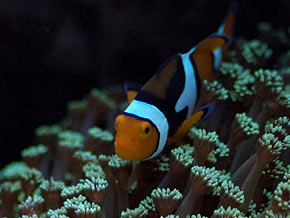
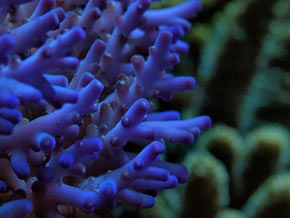
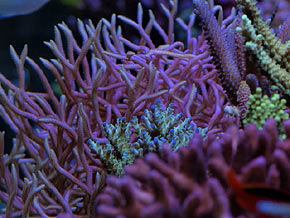
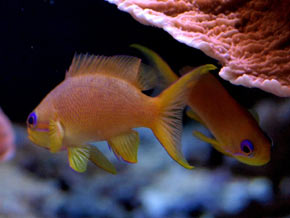
InhabitantsMy tank is dominated by Acropora, including Seriatoporas, Milleporas, Stylophoras, and Tortuosas. Both my Green Bali Slimer and one of my Pink Seriatoporas grow like weeds and have to be fragged often. My Oregon Blue Tortuosas and Purple Cali Tortuosas are my favorites due to their deep, rich colors. Another favorite of mine is something I don’t have a positive ID on. It is a maricultured piece I bought sight unseen from an online retailer. It was sold to me as a Purple Monster but it looks more like an A. lokani or A. turaki. All I know is it has turned into quite a gem! 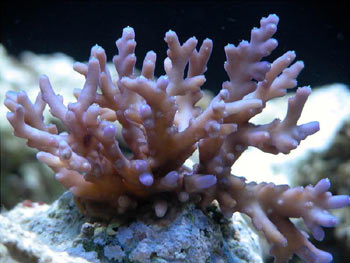
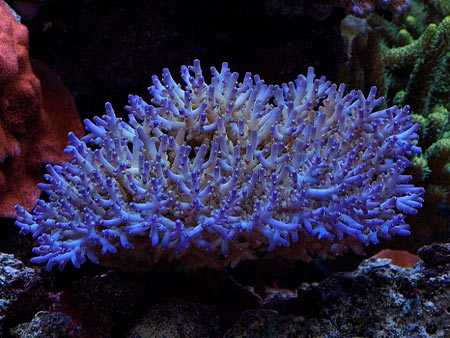
Not everything has been easy with this tank. Last spring I discovered it was infested with the dreaded acro eating flatworm (AEFW) pest. I lost a few colonies so I was certainly bummed. Ripping the tank apart to quarantine and treat all acros was not an option since many were fully encrusted on large rocks. My solution was to use a turkey baster on a weekly basis to blow them off to keep them in check. My clown fish got used to the routine and followed the turkey baster around and ate the buggers as they were launched into the water column. I still do this on a weekly basis and I have only seen one AEFW since last June! They are probably still there but the acros have shown no signs of stress. Stony Corals:
Some Large polyped Scleractinian (stoney) corals (LPS) are located in the bottom-half of the tank, including a green Goniopora, a green and red lobed Brain coral, a Frogspawn coral, a neon green Hammer coral, a red and green Cynarina, an Australian red and green Acanthastrea lordhowensis, and a "Chistmas" Favia. My only 'softies' include a few varieties of zoanthids. As for fish, my favorites are my black spotted Leopard Wrasse and African Leopard Wrasse. I also have a mated pair of True Percula Clownfish and a Borbonius Anthias, a really cool looking fish that is becoming easier to find in stores. My Flame Hawkfish, who my daughter and I named Burt, is a real character. I also recently added a female Bellus Angelfish. Fish:
AcknowledgementsMany thanks to Reefkeeping Magazine and the Reef Central community for recognizing my latest reef tank with this great honor. Reef Central is awesome and I surf it religiously to keep up with the latest trends and information. Of course I have to thank my wife and daughter for putting up with this crazy hobby of mine. I do spend a lot of time on the tank but it is very gratifying to see both of them relaxing in the “fish tank room” enjoying the fruits of my labor. My wife really gets a kick out of showing off the tank, particularly the equipment room downstairs! I would also like to thank Jason Edward, who is the owner of Greenwich Aquaria in Riverside, Connecticut. He was a big help in advising me on setting up this tank. Jason really knows his stuff and has one of the most incredible reefs on display in his store. Rob and Joe are two very knowledgeable staffers and great guys. Finally, my father deserves the most kudos for getting me into the hobby when I was a kid. He kept fish only saltwater tanks when I was young and then re-entered the hobby a few years ago with a small reef tank. He is still partial to fish but has done very well with LPS and a few SPS. In fact, I have my eye on a nice juicy frag of his beautiful purple Acropora nana! Feel free to comment or ask questions about my tank in the Tank of the Month thread on Reef Central.
| ||
|
| ||
|
|